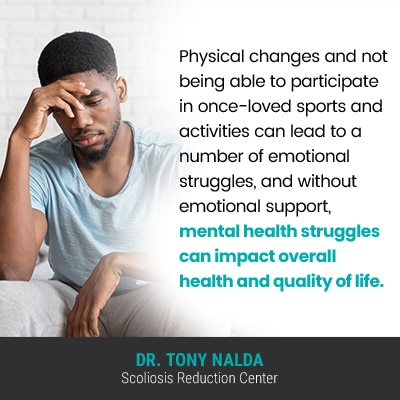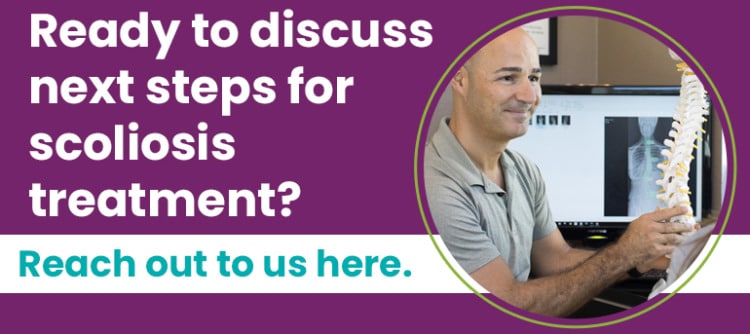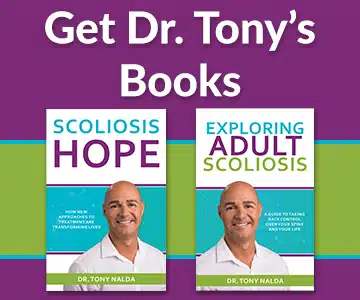Considering the main type of scoliosis is adolescent idiopathic scoliosis, diagnosed between the ages of 10 and 18, this age group is particularly vulnerable to the emotional effects of a scoliosis diagnosis. Most adolescents want to fit in with their peers, don’t want to stand out, and scoliosis can cause changes to posture, balance, coordination, and gait.
Scoliosis can affect the body in a number of ways, and not all are physical. While physical symptoms can include postural changes and pain, being diagnosed with a progressive spinal condition also carries a psychological impact that shouldn’t be overlooked.
Before exploring the emotional effects of a scoliosis diagnosis, let’s first discuss how a diagnosis of scoliosis is reached.
How is Scoliosis Diagnosed?

There are a number of spinal conditions that cause a loss of its healthy curves, but scoliosis has some characteristics that set it apart from the rest, and with current estimates at close to seven million people living with scoliosis in the United States alone, it’s a condition that warrants awareness.
Scoliosis is diagnosed when an unnatural sideways curvature of the spine that also rotates and has a minimum Cobb angle measurement of at least 10 degrees has developed.
Scoliosis is diagnosed through a combined physical examination and X-ray results that confirm the rotational component and a patient’s Cobb angle.
Cobb angle is a measurement taken during X-ray that classifies conditions in terms of severity; the higher the Cobb angle, the more severe the condition, and the more likely it is that its effects are going to be noticeable.
In addition, scoliosis patients recently diagnosed have to hear that the condition is progressive, meaning it’s incurable as its nature is to get worse over time.
Scoliosis ranges widely in severity from mild to moderate and severe to very severe, and treatment plans are shaped around patient age, curvature location, type, and severity.
Now, when it comes to understanding the effects of scoliosis, we can break it down into two separate topics: physical symptoms and emotional symptoms, but first, let’s talk about the condition’s most prevalent type.
Adolescent Idiopathic Scoliosis
There are different types of scoliosis, and all ages can be affected, but the condition’s most-prevalent type is adolescent idiopathic scoliosis, diagnosed between the ages of 10 and 18, and while patients of all ages are entitled to an emotional response to a diagnosis, this age group most often experiences mental health problems related to scoliosis.
Scoliosis progression is triggered by growth and development, so considering the stage of growth these patients are in, it’s the rapid and unpredictable growth spurts of puberty that put adolescents at the highest risk for rapid-phase progression.
As scoliosis progresses, its effects tend to get more noticeable, and it gets more complex to treat, hence the importance of proactive treatment.
So thinking of adolescents for a moment, a typical adolescent wants to fit in with their peers, is already self-conscious about their looks, and is not exactly known for transparency, and these things can be a challenge to early detection because even if an adolescent notices some disruptive postural changes, they might simply hide those changes.
I’ve had numerous young patients who’ve told me they wore baggier clothes when some of the signs of scoliosis first started to appear in an effort to blend in, and of course, the classic adolescent slouch can make postural changes simply look like poor posture, rather than symptoms of a larger condition.
So we’ve defined adolescent idiopathic scoliosis, but let’s now talk about how it affects young people physically and emotionally.
The Physical Symptoms of Adolescent Idiopathic Scoliosis
Each case of scoliosis is unique, and as mentioned earlier, the more severe a condition, the more likely it is that its effects are going to be noticeable.
When it comes to scoliosis in adolescents, oftentimes the earliest signs are uneven shoulders and hips, and this is due to the condition’s uneven forces disrupting the body’s overall symmetry.
Additional postural changes that can negatively affect self image include:
- The head appearing uncentered over the torso
- An uneven eyeline
- Uneven shoulder blades
- The development of a rib cage arch
- An uneven waistline
- Arms and legs that appear to hang at different lengths
Additional changes include disruptions to balance, coordination, and gait; teenagers don’t want to have a walk that’s different from their peers, and they certainly don’t want to wear a scoliosis brace as part of treatment.
The Emotional Symptoms of Scoliosis

As scoliosis is progressive, young patients have to be told that postural changes could continue to get worse, and I’ve definitely heard a lot of recently-diagnosed adolescents express concerns over not being able to wear a bathing suit at the beach with friends and/or not being able to play the sports they love.
Particularly when scoliosis is severe, there can be activity restrictions; sports and activities that are generally considered unsafe for people with scoliosis are those that overuse one side of the body, put the spine in an unnatural position, involves hyperextension, and/or stress from repeated impact.
So imagine, for a moment, a young teenage boy whose life is girls and football, and in an instant, a scoliosis diagnosis can make that patient feel as if neither are possible.
Physical changes and not being able to participate in once-loved sports and activities can lead to a number of emotional struggles, and without emotional support, mental health struggles can impact overall health and quality of life.
There are higher rates of mental health disorders, low self esteem, substance abuse issues, eating disorder, mood disorders, suicidal thoughts, body image issues, issues with social participation, depression, and anxiety in adolescents with scoliosis, than adolescents without scoliosis.
I like to draw attention to the psychological side effects of scoliosis because in the world of medicine, these effects are often overlooked as the focus is on addressing the more overt physical symptoms.
So how can we help young people recently diagnosed with scoliosis process the news in a way that’s healthy, can facilitate happy lives, and minimize the psychological effects?
How to Support Young Scoliosis Patients
It can be difficult for family members to know what to say to help a young patient receiving the news that they have a progressive spinal condition capable of changing their appearance and activities.
One thing that I like to draw attention to when talking about conditions with patients is that even though we don’t know what causes the initial development of adolescent idiopathic scoliosis, we most certainly know how to treat it.
I am also clear that a diagnosis of scoliosis doesn’t have to mean a life of limitation, and this is a good time to mention a number of famous celebrities and athletes who continue to thrive despite having scoliosis.
Young adults have a lot of stress in the modern world, particularly with social media adding additional pressure to look a certain way and lead a certain type of life, and there is no doubt that young adults facing the stress of any medical condition are at a higher risk for mental health issues; the best way to avoid this is to have an open dialogue with teens about their struggles and also to treat it proactively so the condition’s effects are minimized.
Conclusion
There was a time when the connection between physical and mental health wasn’t fully understood, but we now know that they are intertwined, and here at the Scoliosis Reduction Center®, scoliosis treatment means treating the whole patient, and that means not only addressing physical symptoms, but also empowering young people so they can handle the emotional symptoms.
The less support young people have, the more likely it is that mental health conditions and elevated levels of stress will take a toll on someone’s life and well being.
Research on the psychological impact of a scoliosis diagnosis supports the higher rates of mental health issues in young patients with scoliosis, and it’s important for parents and/or caregivers to understand both the physical and emotional struggles associated with adolescent idiopathic scoliosis.
When it comes to treating adolescent idiopathic scoliosis, another factor that leads to social participation lower rates is corrective bracing as a facet of treatment; conservative treatment can help patients avoid progression and the potential complications of spinal surgery, and corrective bracing can be particularly effective on growing spines.
Scoliosis braces often have to be worn full time, and this can mean at school, and while corrective bracing is far more discreet and comfortable than traditional scoliosis braces, they can make young patients feel more self-conscious about their condition, and in addition, while wearing a brace, there tend to more activity restrictions that can contribute to quality of life issues.
Any physical deformity has the potential to cause body image issues and is a risk factor for a number of mental health disorders, and scoliosis is no exception.
Parents and caregivers can arm themselves with awareness so they are prepared to support their loved one in a way that minimizes the potential psychological impact of a scoliosis diagnosis and treatment.




